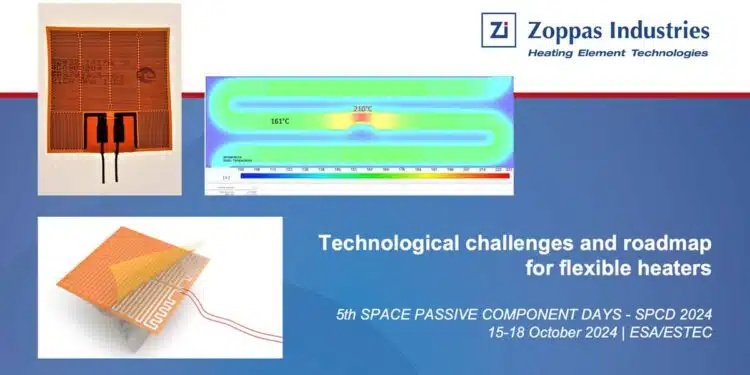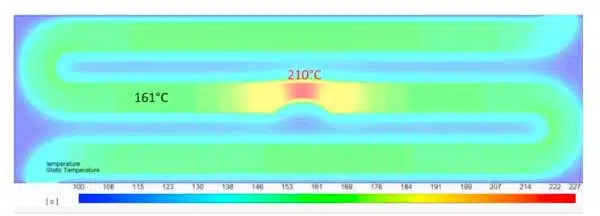This paper about flexible heaters challenges was presented by Alessandra Marcer, IRCA S.p.A. Italy during the 5th Space Passive Component Days (SPCD), an International Symposium held from October 15th to 18th, 2024, at ESA/ESTEC in Noordwijk, the Netherlands. Published under permission from ESA SPCD organizers.
Flexible heaters, used for thermal control in space applications, are being developed with a focus on size and weight reduction, reliability, and safety. ZIHET, a supplier of space heaters, offers various options for redundancy and has developed a numerical tool (EFsim) to support the application of derating rules. The ECSS derating rule for heaters has been updated to prioritize temperature margin over maximum power, providing a clearer and safer guideline for designers.
ZIHET offers flexible heaters with integrated temperature sensors for accurate modeling and calibration of heater input power, ensuring reliable operations in space. These heaters, qualified for extreme temperatures from -65°C to +200°C, have been successfully used in space missions and are undergoing ESCC qualification for embedded sensors. ZIHET also offers a new product, the Pure Polyimide Heater (PPH), with higher temperature capabilities and improved thermal performance, suitable for long-duration and interplanetary missions.
A 1D thermal model for flexible heaters was validated using 3D numerical simulations and experimental testing. The model, which considers track thickness variations and material conductivity, accurately predicts temperature profiles and is suitable for sizing purposes. Experimental results confirmed the model’s accuracy, demonstrating its effectiveness in predicting thermal behavior for flexible heater applications.
Flexible heaters for space applications require rigorous testing and qualification to ensure they meet demanding space environment standards. ZIHET, a company specializing in space-qualified flexible heaters, invests in research and development to improve performance and reliability. ZIHET also offers various qualification levels to cater to different customer needs and markets, including institutional, military, commercial, and ground testing facilities.
Key Points
- Flexible Heater Technology: Etched foil resistive element laminated between two insulation layers, providing fast heat-up and cool-down rates with uniform heat distribution.
- Applications: Widely used for thermal control in satellites and inhabited modules, including piping, electronics, batteries, structures, optics, and detectors.
- Technical Challenges and Solutions: Addressing challenges related to derating rules and thermal system design with new tools and support.
- Manufacturing Process: Involves etching for precise control, lamination with insulation layers, and electrical termination with silver-plated copper wires.
- Insulation and Protection: Features thin, flexible insulation layers made of Polyimide Polymer/FEP or Polyimide Film/Acrylic Adhesive, providing electrical, thermal, and mechanical protection.
- Technological Challenges: Primarily involve thermal efficiency, reliability, safety, and resistance to extreme space environments.
- Size and Weight Optimization: Flexible heating technologies are lightweight and compact, enabling efficient use of space in space missions.
- Reliability and Certification: ZIHET heaters are ESA/ESCC-qualified, ensuring full flight compatibility and offering redundancy options for enhanced reliability.
Technological challenges and roadmap for flexible heaters.
Introduction
Flexible heating elements consist of etched foil resistive elements laminated between insulation layers. IRCA S.p.a. – ZIHET (Zoppas Industries Heating Element Technologies) produces ESCC-qualified flexible heating foils and are included in ESA QPL. They provide fast heat-up and cool-down rates, ensuring uniform heat distribution at various watt densities. This versatile product is widely used for thermal control in satellites and inhabited modules, including piping, electronics, batteries, structures, optics, and detectors.
Flexible heaters are the cornerstone of ZIHET’s space market portfolio, with a roadmap to expand capabilities and keep pace with the evolving space economy.
Technological Challenges
The etching process precisely controls the heating element’s geometry and resistivity. Insulation layers laminate the resistive foil and terminal leads between thin, flexible insulation materials (Polyimide Polymer/FEP or Polyimide Film/Acrylic Adhesive). These layers provide electrical isolation, thermal insulation, and mechanical protection.
Lamination under heat and pressure creates a robust, flexible heating assembly using specialized adhesives. Electrically welded terminal leads and connecting wires made of multi-strand silver-plated copper ensure a strong connection. The wire gauge is defined by the applicable specification.
Flexible heaters are manufactured to meet customer needs in dimensions, shape, resistance, and circuit count. Technological challenges for space-qualified flexible heaters include thermal efficiency, reliability, safety, and resistance to extreme space environments. ZIHET actively supports and solves challenges in the development of space heaters.
Size and weight reduction are crucial for space missions. Flexible heaters are lightweight and compact, enabling efficient space use. They start with a minimum thickness of 0.15 mm and can reach an electrical resistance of 330 Ω/cm².
Reliability and derating
Reliability and derating are essential for space heaters. ZIHET is a global supplier of heaters and systems for space satellites, spacecraft, pressurized modules, and ground-based antennas. ESA/ESCC-qualified since 1992, ZIHET’s products are fully flight compatible.
ZIHET offers redundancy options, including single circuit heaters, double circuit heaters, and double-layer heaters. Derating rules are also applied to increase heater reliability. The ECSS-Q-ST-30-11C standard provides the applicable derating rule for heaters. ZIHET has participated in discussions with users to ensure correct interpretation and application of this rule.
Some users faced difficulties due to the lack of a generic rule on the maximum heater power. The concerns were raised about applicable input power level for heaters suspended in still air, intended for manufacturers’ internal qualification tests. In example heater attached to a spacecraft substrate under mission thermal conditions, which is affected by the environment and material properties. Evaluating this parameter at the component level is complex and requires a system-level approach considering all involved parameters.
To support customers with a first estimation, ZIHET developed EFsim, a numerical simulation tool.
The updated rule in Rev.2 requires powering heaters while ensuring a 50°C margin on the maximum qualification temperature. This rule provides a clearer and safer guideline based on temperature, specifying a margin between the maximum reachable temperature and the materials’ qualification higher limit. Heater manufacturers provide the operative temperature range based on materials and configuration, which is always provided in line with ESCC rules. Users must ensure that these limits are respected through direct or indirect temperature control during usage.
This new rule simplifies thermal system and heater design, aligns with available resources, and is more practical. ZIHET supports designing heaters less conservatively while ensuring requested quality and reliability standards. Users need to know the operative heater temperature during ground testing and correlation.
ZIHET provides flexible heaters with integrated temperature sensors (PT100/PT1000/NTC) for ground testing. Precise temperature measurements allow accurate heater input power modeling and calibration, which can be directly applied in flight since the heaters used for ground testing and on flight are the same (ESCC qualified).
Thermal data can validate heater performance and ensure reliable operations. RTD sensors (PT100, PT1000, NTC, and thermocouples) and space-qualified manufacturers are available. ESCC QPL qualification is ongoing and will be completed by 2025.
Operations in extreme environments
Space-qualified flexible heaters withstand extreme temperatures, from -65°C to +200°C. Recent confirmation shows ZIHET heaters can support even more extreme missions, such as restoring the Euclid telescope’s primary mirror functionality. Water molecules deposited on the mirror after launch from the multi-layer insulation (MLI) were removed by the heaters.
Reducing visibility by about 15%, the heaters successfully warmed the mirror from -147°C to -113°C in 100 minutes, sublimating the ice and restoring functionality.
ZIHET is also ESCC-qualifying the “Pure polyimide heater” (PPH), reaching even higher temperatures (up to +260°C). Developed and UL certified for the medical market, it offers the best solution for highly specific power, low thickness, and excellent thermal transmission. It can be provided with single or double insulation and single or double layer (primary and redundant, or heater + sensor).
Key advantages include:
- Very low thermal mass and thickness (minimum 50 microns overall)
- No additional glue required for bonding the heater or heatsink plate
- Full free design and optimized power density
- Max temperature up to 260°C and high specific power (up to 15W/cm2)
- Higher ohm density (up to 330Ω/cm2)
- Any possible shape or combination of heaters for extra length
- Low outgassing compared to epoxy/acrylic technology
- Resistance to many chemicals
- Higher radiation hardness compared to current technologies (attractive for long-duration and interplanetary missions)
Heat management and Design optimization
Heat management and design optimization involve selecting the heater’s shape, dimensions, resistance, and redundancy, as well as materials and fastening methodologies for mounting. Heatsink and power budget sizing based on operating temperature are considered.
ZIHET flexible heaters can be equipped with optional PSA (3M 966) for optimal bonding on satellite components. An additional aluminum substrate distributes heat evenly and can also be used for grounding. The tool instantly gives heater temperatures and plots maximum power density based on heat sink temperature.
High-reliability materials
High-reliability materials are crucial for space-qualified flexible heaters. They must maintain mechanical and electrical properties in space conditions, including ionizing radiation, vacuum, vibrations, and thermal shocks.
Materials and processes for ZIHET flexible heaters adhere to ESA regulations for outgassing and reliability. All raw materials meet high-quality standards and comply with ESA and EU regulations. ZIHET’s Purchasing & Supplier departments collaborate closely with Quality managers to ensure proper raw material quality.
This aspect has been critical due to the absence of a qualified European production chain for Kapton-FEP insulation and non-European suppliers not always meeting ESCC requirements. ZIHET has engaged in discussions with ASI, ESA, and DEFIS to establish a fully European supply chain for these critical materials.
Integration with other components
Flexible heaters are designed for easy integration with space platform components. Their thickness and flexibility allow application to complex shapes and geometries without compromising efficiency or dependability.
Traditionally, heaters on satellites have been integrated manually through power cable connections to the on-board harness. However, connectors are increasingly used, especially for commercial constellations, facilitating serialized production and agile processes.
ZIHET procures assemblies with space-graded connectors to ease electrical interface integration with the on-board power subsystem. By 2024, ZIHET will achieve ESA certification in compliance with the ECSS-ST-Q-70-26C “Crimping of high-reliability electrical connections” standard, and the QML ESCC qualification process will follow in 2025.
Testing and qualification
Rigorous testing and qualification ensure heaters meet space standards, including visual inspection, electrical measurements, thermal shocks, and life tests. ZIHET also offers commercial qualification levels like QM and PFM to comply with the demanding space environment.
Conclusions
In-depth space knowledge and advanced engineering skills are required for designing flexible heaters and integrating them with complex space systems. Companies producing space-qualified flexible heaters must invest in research and development to improve performance and reliability. ZIHET is actively developing a technological roadmap to expand its space product portfolio, including new solutions leveraging expertise in medical, aerospace, and automotive markets. Examples include high-performance heaters with all-polyimide material and integrated connectors.
ZIHET has a dedicated R&D department specializing in material properties and engineering. They continuously explore new techniques and solutions across all markets, focusing on space-grade compatibility.
Read the full paper:

































